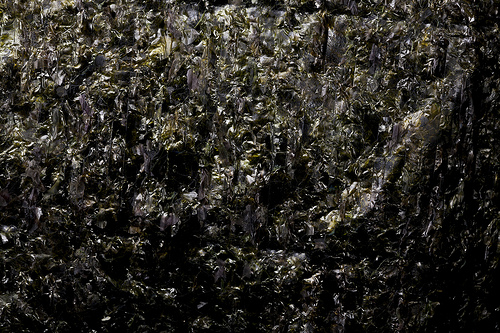Faces crinkle when nori is eaten!
- Nori is a food item traditionally eaten as part of Japanese and Korean cuisine, and it is also consumed in China, but is less common.
- Typically nori is made of an edible species of red seaweed, from the Pyropia and Porphyra genera, such as Pyropia yezoensis (the most commonly used species) and Pyropia tenera, both of which were previously part of the Porphyra genus, that are especially farmed for this purpose.
- Nori is made by washing the seaweed in clean water, cutting it into small pieces via a machine, mixing the pieces with water and pouring the mixture onto mats to create sheets, which are passed through a drier, after which the sheets may be toasted, a process comparable to that of paper-making.
- Nori is traditionally used as a wrapping around rice to make sushi and onigiri, and it may be used to flavour other rice dishes as well as soup and noodles.
- Nori can be found in Asian grocery stores, although it is becoming increasingly common to find the product in general supermarkets, and it is typically sold as sheets in airtight packets, often including a moisture absorbent, as the product is susceptible to moisture, and thus should be stored in a dry place.
Nori
Image courtesy of John Lodder/Flickr
- The production of nori has occurred since at least 700 AD, as a paste, although it was not made into dry sheets until the early 1700s, while British scientist, Kathleen Drew-Baker contributed to a major breakthrough in the industry in the mid 1900s, and ‘one man’ machines have also revolutionised production since 1975.
- Japan is the greatest producer of nori in the world, and produced 10 billion sheets in 2003, and it is the most widely eaten seaweed in Japan.
- Nori is very high in iodine and is high in vitamin A, vitamin C and manganese, and contains many other vitamins and minerals.
- ‘Nori’ is also known as ‘laver’ in some western cultures, and it can be flavoured and eaten as a food by itself, and it has a crispy texture in the packet, but once it is in use, it becomes limp and chewy.
- The darker the colour of nori, the higher quality it is, and the product is typically roasted or toasted before consuming, although this is often done prior to packaging, which will turn it from a deep red, purple or almost black colour, to a dark green.
Bibliography:
About Seaweed, 2014, Seaweed Industry Association, https://seaweedindustry.com/seaweed/type/pyropia-yezoensis
Nori, 2015, All About Sushi Guide, http://www.allaboutsushiguide.com/nori.html
Nori, 2015, Wikipedia, https://en.wikipedia.org/wiki/Nori
Reavis R, Nori – Japan’s Most Famous Seaweed: Part I, History and Traditional Use, 2012, Glendale Community College Blog, https://glendalecommunitycollege.wordpress.com/2012/05/03/nori-japans-most-famous-seaweed-part-i-history-and-traditional-use/






